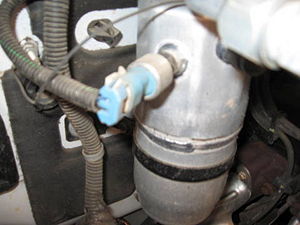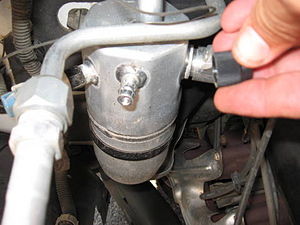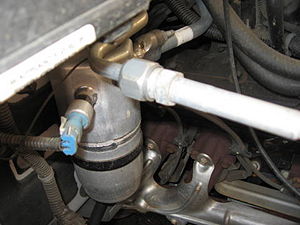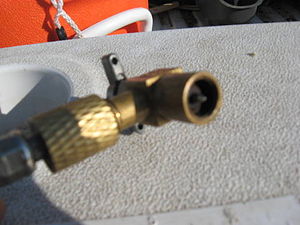How To Recharge the Air Conditioner in a Car See more: How To Recharge the Air Conditioner in a Car | Guide (12 Steps) « Wonder How To http://www.wonderhowto.com/how-to-recharge-air-conditioner-car-074192/#ixzz173FPo2u7
step1
 Determine if you have any refrigerant left in your system at all. To do this, you will need to fit a charging hose on the low pressure port, discussed later. Be sure to use eye protection. If your system is completely discharged, it may be contaminated with moisture, and charging will not give satisfactory results unless the source of the leak is found, repaired and the receiver dryer replaced. The open system must be repaired and purged using a vacuum pump to remove air and moisture. You will also want to add compressor oil if the system has been leaking. Evidence of oil leakage and measurement of oil left in a replaced compressor will be a guide as to how much oil to replace
See more: How To Recharge the Air Conditioner in a Car
Determine if you have any refrigerant left in your system at all. To do this, you will need to fit a charging hose on the low pressure port, discussed later. Be sure to use eye protection. If your system is completely discharged, it may be contaminated with moisture, and charging will not give satisfactory results unless the source of the leak is found, repaired and the receiver dryer replaced. The open system must be repaired and purged using a vacuum pump to remove air and moisture. You will also want to add compressor oil if the system has been leaking. Evidence of oil leakage and measurement of oil left in a replaced compressor will be a guide as to how much oil to replace
See more: How To Recharge the Air Conditioner in a Car
step2
Check for any obvious leaks. If your system has lost sufficient refrigerant to quit working, you have a leak. Small leaks may take months to deplete the refrigerant so that the AC fails to cool, but charging a system with a significant leak is simply a waste of time. Look for refrigerant oil residue on hose, tubing, and fittings that are part of the refrigerant system. Spray a soapy water solution on fittings and watch for bubbles to appear, indicating a leak.
step3
Make sure the condensing coils are not obstructed with debris, and that the compressor is operating. To test a compressor with a low charge you may need to jump the pressure switch, often located on the accumulator.
step4
 Purge the charging hose by opening the valve until you hear it fill with refrigerant, then slowly loosening the brass fitting that connects the hose to the valve. Be careful not to allow refrigerant to spray on bare skin, as this will freeze skin tissue on contact. Re-tighten the hose once you have heard refrigerant escaping, this should have forced any air (and moisture) from the hose.
Purge the charging hose by opening the valve until you hear it fill with refrigerant, then slowly loosening the brass fitting that connects the hose to the valve. Be careful not to allow refrigerant to spray on bare skin, as this will freeze skin tissue on contact. Re-tighten the hose once you have heard refrigerant escaping, this should have forced any air (and moisture) from the hose.
Crank your engine and turn the AC on high cool, high fan. If your recharging hose is equipped with a pressure gauge, check it to determine if the system needs refrigerant. If the pressure holds steady in the recommended range, the system is full and should not be charged. If the pressure is below the recommended range, follow the instructions to recharge the system. Another indicator that the system needs refrigerant is that the compressor cycles rapidly. If the compressor switches on and off every 5 to 20 seconds, it is most likely due to low pressure. You will see the pressure drop when the compressor kicks on, the compressor will shut off when the pressure gets too low, and the pressure rises back up to the operating range as the system equalizes. Compressor cycling (switching on and off) in a completely charged system should be very slow (every 30 seconds or up) or not at all present (compressor stays on) in hot weather.
step 12
 Determine if you have any refrigerant left in your system at all. To do this, you will need to fit a charging hose on the low pressure port, discussed later. Be sure to use eye protection. If your system is completely discharged, it may be contaminated with moisture, and charging will not give satisfactory results unless the source of the leak is found, repaired and the receiver dryer replaced. The open system must be repaired and purged using a vacuum pump to remove air and moisture. You will also want to add compressor oil if the system has been leaking. Evidence of oil leakage and measurement of oil left in a replaced compressor will be a guide as to how much oil to replace
See more: How To Recharge the Air Conditioner in a Car
Determine if you have any refrigerant left in your system at all. To do this, you will need to fit a charging hose on the low pressure port, discussed later. Be sure to use eye protection. If your system is completely discharged, it may be contaminated with moisture, and charging will not give satisfactory results unless the source of the leak is found, repaired and the receiver dryer replaced. The open system must be repaired and purged using a vacuum pump to remove air and moisture. You will also want to add compressor oil if the system has been leaking. Evidence of oil leakage and measurement of oil left in a replaced compressor will be a guide as to how much oil to replace
See more: How To Recharge the Air Conditioner in a Car step2
Check for any obvious leaks. If your system has lost sufficient refrigerant to quit working, you have a leak. Small leaks may take months to deplete the refrigerant so that the AC fails to cool, but charging a system with a significant leak is simply a waste of time. Look for refrigerant oil residue on hose, tubing, and fittings that are part of the refrigerant system. Spray a soapy water solution on fittings and watch for bubbles to appear, indicating a leak.
step3
Make sure the condensing coils are not obstructed with debris, and that the compressor is operating. To test a compressor with a low charge you may need to jump the pressure switch, often located on the accumulator.
step4
Tap your refrigerant can. This is done by opening the valve on the tapping fitting completely open, which retracts the tapping pin into the valve body. Failing to do so will result in the tap puncturing the can when it is installed, releasing the refrigerant before the fitting is sealed.
step5
step5
Securely thread the tapping valve on the refrigerant can, close the valve completely shut. This drives the pin into the top of the can, making it possible to release the refrigerant when the valve is opened.
step6
 Purge the charging hose by opening the valve until you hear it fill with refrigerant, then slowly loosening the brass fitting that connects the hose to the valve. Be careful not to allow refrigerant to spray on bare skin, as this will freeze skin tissue on contact. Re-tighten the hose once you have heard refrigerant escaping, this should have forced any air (and moisture) from the hose.
Purge the charging hose by opening the valve until you hear it fill with refrigerant, then slowly loosening the brass fitting that connects the hose to the valve. Be careful not to allow refrigerant to spray on bare skin, as this will freeze skin tissue on contact. Re-tighten the hose once you have heard refrigerant escaping, this should have forced any air (and moisture) from the hose.
step 7
Locate the low pressure charging port on the refrigerant line on your car. This will be on the larger tube, usually near or on the accumulator. Connect the quick coupling and make sure it is not leaking.
step8
Crank your engine and turn the AC on high cool, high fan. If your recharging hose is equipped with a pressure gauge, check it to determine if the system needs refrigerant. If the pressure holds steady in the recommended range, the system is full and should not be charged. If the pressure is below the recommended range, follow the instructions to recharge the system. Another indicator that the system needs refrigerant is that the compressor cycles rapidly. If the compressor switches on and off every 5 to 20 seconds, it is most likely due to low pressure. You will see the pressure drop when the compressor kicks on, the compressor will shut off when the pressure gets too low, and the pressure rises back up to the operating range as the system equalizes. Compressor cycling (switching on and off) in a completely charged system should be very slow (every 30 seconds or up) or not at all present (compressor stays on) in hot weather.
step9
Open the valve until you hear refrigerant passing through the hose.
step 10
step 10
Allow the can to dispense its contents. This often takes anywhere from two to five minutes. The hotter the outside temperature, the more quickly the contents will discharge. Keep the can with the tap up at all times, to allow non-liquid refrigerant into the suction side of the system to prevent compressor damage. Do Not overcharge! A manifold gauge should be used to measure both high and low side pressure. Consult a Pressure temperature chart.
step 11
step 11
Close the valve and disconnect the hose when the can is empty or no longer discharging enough to keep the can cold. Check the charging port for leaks, and replace the plastic cap.
step 12
Check the air from the AC vents in the car. It should be blowing cold (38-45 degrees), if not, either one can of refrigerant was not sufficient to charge the system, or some other component is the problem. Do Not overcharge! A manifold gauge should be used to measure both high and low side pressure. Consult a Pressure temperature chart.
Tips
- Get a recharging kit that includes a pressure gauge. Beware that once the low side reaches around 30 psi the highside can continue to increase to excessive pressure levels if not monitored - do not overcharge, fix leaks use a manifold gauge set and be safe!
- If your car is earlier than approximately 1993, the air conditioning will operate on R12 which is now obsolete. However there are replacement refrigerants such as Freeze12 which will not require you to convert your system to R134a in order to recharge.
- Later vehicles run on R134a. These systems have different size ports, making identification easy.
- You can get an R12 to R134a conversion kit at an auto parts store, but should consider having it done professionally.
Warnings
- Beware that once the low side reaches around 30 psi the highside can continue to increase to excessive pressure levels if not monitored - do not overcharge, fix leaks use a manifold gauge set and be safe!
- Don't buy just the R-134a refill unless you already have the entire kit. Also, this will not have the right tip for the R-12 type fillers.
- Don't mix R-12 and R-134 refrigerant. This is illegal, and won't work anyway. R12 and R134a require different oil for lubrication. R-12 systems use a mineral oil, R-134a systems use a PAG oil. A mixture of the two could (and probably will) damage the compressor, the most expensive part of the A/C system. If you change the compressor, you must also change the filter/dryer and may have to flush the condenser. The only oil to use on a conversion is an "ester" type oil. This will be the most compatible with any remaining mineral oil still in the system.
- R-12 is no longer used because it contains CFCs and is harmful to the environment if it gets out of the system.
- R-12 is more expensive and requires a license to buy, so it may be cheaper to have your A/C converted to R-134A. It's best not to do the conversion yourself - the EPA has strict rules requiring recycling of all refrigerants and prohibiting its release into the atmosphere, and specialized equipment is required to correctly perform the conversion.



Comments
Post a Comment